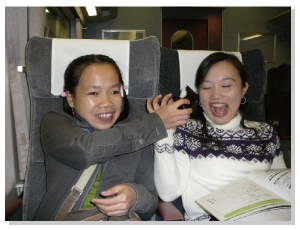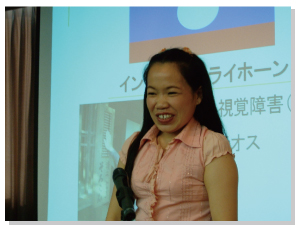- HOME
- Alumni News
- Inpeng Vilayhong (8th trainee)
- Inpeng's Final Report
Inpeng's Final Report
Training report
Coming to Japan
I arrived in Japan on September 1 2006, and met other trainees and Duskin staff at the Kansai Airport. As my English was not good, and as I could speak no Japanese, I did not speak to anyone.
Japanese language training
I studied Japanese for three months with the other trainees. The other trainees seemed to be enjoying themselves a lot as they understood Japanese very well. I did not enjoy because I could not understand Japanese that much. But the teachers were always very kind and instructed me patiently. As I began to understand Japanese, studying it became a lot more enjoyable.
Swimming training
Between September and November, I had swimming lessons every Thursday. As I had never swum before, it was extremely difficult. But the teachers instructed me patiently and I began to understand how to swim, and managed to swim 25 meters. At the beginning I never thought I would be able to swim that much. It was a lot of fun and extremely exciting.
Ski training
In January, we had ski training. We went to the ski piste by bus. After we got off the bus, ski instructors came to pick us up and took us to the piste. We practiced on an easy slope at first and after a while we went on the lift to go to the top of the mountain. As I was eager to learn to ski I was not afraid at all. But after falling over many times and my body feeling sore, I began to feel the fear. However, I continued to exercise skiing a lot despite the pain as I wanted to ski more. As I skied better it became very enjoyable.
Laos is a very hot country and there is no snow. I had studied about snow when I was a junior high school student, but never in my life imagined that I would have an opportunity to touch snow. I had also heard about skiing but did not really know what it was like. In Japan, I touched the snow and I also skied. It was extremely touching and unforgettable.

Homestay
I had two homestay experiences.
The first was during the Japanese New Year. There were my friends with visual impairment, and also friends who could see. We went out together every day and enjoyed New Year shopping. We also learned a lot about Japanese tradition. Japanese tradition is slightly similar to Laos. While we stayed at home, we played cards. It was a lot of fun.
My second homestay was in Hiratsuka, with only the father and mother. The mother gave me a lift everyday from home to the bus stop. From there, I got on the bus by myself to attend training programs. After training program, I got on the bus and went back by myself, the father waited for me at the bus stop. When I got home I cooked together with the mother. While we were cooking, the mother taught me a lot about Japanese cooking. We ate together and talked about Japanese culture and families. There was a karaoke set at home so the father and mother sang for me. It was very enjoyable.
There was also another friend for Myanmar in this homestay program. This friend stayed with us only on Saturdays and Sundays. We became great friends and talked and laughed together, and had a lot of fun. When the mother cooked, we both helped out, like real sisters. It was only a short period of time that I spent with this friend but it was as if I had known her for a long time.
This homestay program was for a period of three weeks. It was as if I stayed with my own father and mother. Their children are not people with disabilities, but they understood the circumstances and feelings of people with visually impairments. I am extremely grateful to the father and mother.
Individual training
I studied welfare for people with disabilities, education for people with visual impairments, and workshops. The situation for people with visual impairments in Laos is not very good yet so my training mostly encompassed topics about people with visually impairments and did not cover other disabilities, but I always made sure to ask questions about other disabilities to learn. I was very impressed to find that Japan has many support systems and services for people with disabilities.
After the homestay programs, individual training programs had started. I attended personal computer training, and other programs at Hamamatsu Workshop with the Disabled-WITH- in Hamamatsu, Koyukai in Kanagawa, Japan Braille Library, Asian Development with the Disabled Persons, Hiratsuka School for the Blind. I would like to introduce a few of these programs.
WITH
Between February and March, I attended a training program at WITH in Hamamatsu and studied about workshops for people with visual impairment. At WITH, people made white canes, printed Braille and produced many other things. They included people who lost vision in adulthood, people who could not see and also had physical weaknesses, and people who could not see and had intellectual disabilities. But everyone looked energized and happy when they came to WITH and saw their friends. It was not only because of work they went to WITH—but also for happiness and a sense of purpose of life, and I thought it was extremely important.
At WITH, Mr Shiba not only taught me about workshops but took me to many schools. Mr Shiba was working to enlighten the pupils at these schools. He told the children about the lives of people with visual impairment, guide dogs, and about other people with disabilities. It was a good learning opportunity for me as well.
I did not understand Japanese very much when I had the individual training in Hamamatsu, but Mr Shiba and other members of staff at WITH were very kind to me. They taught me about many disabilities and also new Japanese words. I would like to extend my most sincere gratitude to them.
Koyukai
In March, I attended a training program at Koyukai, in Kanagawa Prefecture. I learned about massage, various activities and jobs of people with disabilities, mobility orientation, and sports for the blind. I also went to see many facilities for people with disabilities. There were many facilities for people with disabilities within Koyukai as well, including workplaces, rehabilitation areas and care centers for people with disabilities, which were all very impressive.
At Koyukai, Ms Igarashi and other members of staff at Koyukai took me to many places. When I talked to them about cherry blossoms, they remembered it and brought me real cherry blossoms. They were very cute and smelt gorgeous.
Asian Development with the Disabled Persons
y individual training in April was at Asian Development with the Disabled Persons (ADDP), which is currently supporting people with disabilities in Laos. Even though I lived in Laos I did not know much about the people with disabilities in Laos, so I learned a lot from ADDP’s staff. They also helped me a lot in thinking about what I would like to do when I return to Laos, and said that they would work together with me and support me. So I was extremely happy.
How I changed in Japan
Before coming to Japan I was volunteering as a masseuse and I also helped out at a school for the blind. My life was just going back and forth between the school and the massage facility. I did not know what people with disabilities were able to do; my life was extremely limited and I had no hopes or dreams. But after learning about a variety of things in Japan, I understood that I could do many things despite the disability. I now have many ideas and many hopes. I think entirely differently from before.

My dreams
When I go back to my country, I would like to become a leader for people with disabilities. I would like to utilize the knowledge and experiences I gained in Japan to increase opportunities for education and employment for people with disabilities.
I have two dreams; the first, is to improve education for people with visual impairments. There is education for people with visual impairments in Laos, but it is not enough. For example there are only two schools for the blind in Laos. It is possible for people with visual impairments to study from elementary school up to high school, but there are not enough resources. Universities are not open to these people after graduating from the high schools. The only place that they can go to is a special polytechnic. I would like to change the education system in Laos so that people with visual impairments can also go to universities.
The second dream I have, is to establish a workshop center for people with disabilities. Because I would let people who are or have been unable to study, or people who have not been able to work very much, that it is possible for them to have a sense of purpose in life and have a happy life.
Lastly
I would like to say thank you to the Duskin AINOWA Foundation and Japanese Society for Rehabilitation of Persons with Disabilities. Thanks to Duskin’s support, I was able to study in Japan what I wanted to learn. The staff at Japanese Society for Rehabilitation of Persons with Disabilities also helped me tremendously in all areas. Thank you very much, everyone.




